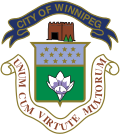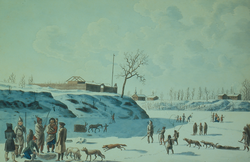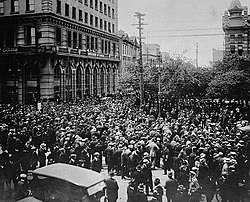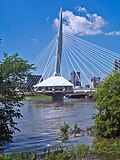Winnipeg
Winnipeg (pronounced /ˈwɪnɨpɛg/) is the largest city of Manitoba, Canada, and is in the eastern prairie region of Western Canada. It is often called the "Gateway to the West."[11][12] Winnipeg is the sixth-largest city in Canada with a population around 750,000 people.[6]
City | |
| City of Winnipeg | |
Winnipeg panorama featuring the Canadian Museum for Human Rights | |
|
| |
|
| |
| Coordinates: 49°53′04″N 97°08′47″W / 49.88444°N 97.14639°WCoordinates: 49°53′04″N 97°08′47″W / 49.88444°N 97.14639°W[2] | |
| Country | Canada |
| Province | Manitoba |
| Region | Winnipeg Metropolitan Region |
| Incorporated | 1873 |
| Named for | Lake Winnipeg |
| Government | |
| • Mayor | Scott Gillingham |
| • Governing body | Winnipeg City Council |
| Area | |
| • Land | 461.78 km2 (178.29 sq mi) |
| • Metro | 5,285.46 km2 (2,040.73 sq mi) |
| Elevation | 239 m (784 ft) |
| Population | |
| • City | 749,607 (6th) |
| • Density | 1,623/km2 (4,200/sq mi) |
| • Urban | 758,515 (7th) |
| • Metro | 834,678 (8th) |
| Time zone | UTC−6 (CST) |
| • Summer (DST) | UTC−5 (CDT[8]) |
| GDP (Winnipeg CMA) | CA$45.0 billion (2020)[9] |
| GDP per capita (Winnipeg CMA) | CA$50,510 (2021)[10] |
| Website | www |
The city's name comes from the Cree word for "muddy waters." In the city, the Red River of the North and the Assiniboine Rivers join. The area is known as "The Forks."
Winnipeg has four professional sports teams: the Winnipeg Blue Bombers, who play football; the Winnipeg Jets, who play hockey; the Winnipeg Goldeyes, who play baseball; and the Valour FC, who play soccer. Winnipeg has four universities: the University of Manitoba, the University of Winnipeg, Canadian Mennonite University and University of St. Boniface.
Winnipeg is in a very flat part of Canada and has three main rivers: the Red River, the Assiniboine River, the and Seine River, as well as the nearby La Salle River and many more. Winnipeg often has floods in the spring because it is in a very flat area that gets a lot of snow and rain. In the winter, Winnipeg is cold and gets a lot of snow. The hottest day in Winnipeg was in 1936, when it was 42 °C. The coldest day in Winnipeg was year 1879, when it was -47 °C.
History
The area that is now Winnipeg was used by many First Nations people for many thousands of years before people from Europe arrived. The area was important because it is where two rivers met; the Red River and the Assiniboine. First Nations often moved around using the rivers on canoes, small boats that are powered by people with paddles.
Cityscape
Winnipeg has a downtown area in the middle of the city that has many tall buildings, with many offices and stores. All around Winnipeg's downtown are residential neighbourhoods, where people live, including the West End, North End, the French quarter of St. Boniface, St. Vital, West Kildonan, Garden City, North Kildonan, Elmwood and East Kildonan, River Heights, Tuxedo, St. James, Westwood, Transcona, Charleswood, Waverly West, Wildwood, and more.
There is a big road that goes all the way around the city, called the Perimeter Highway. The two most known roads in Winnipeg are called Portage Avenue and Main Street. Both roads meet is in the middle of Winnipeg's downtown area. Main Street goes from the middle of the city to the northern part of the city. Portage Avenue goes from the middle of the city to the western part of the city.
Politics
The mayor of Winnipeg makes decisions about the city in City Hall, in downtown Winnipeg. Winnipeg's mayor is Scott Gillingham.
The provincial premier makes decisions about Manitoba at the legislative building. Its provincial premier is Wab Kinew.
Winnipeg's Legislative Building, where Manitoba politics happen
Television
| OTA virtual channel (PSIP) |
OTA channel | Shaw Cable | Call Sign | Network | Notes |
|---|---|---|---|---|---|
| 6.1 | 27 (UHF) | 2 | CBWT-DT | CBC Television | |
| 9.1 | 40 (UHF) | 12 | CKND-DT | Global | |
| 13.1 | 13 (very high frequency) | 8 | CHMI-DT | Citytv |
Winnipeg Media
An 1821 painting of winter fishing on the ice of the Assiniboine and Red rivers. Fort Gibraltar was erected in 1809.
Crowd gathered outside old City Hall during the Winnipeg General Strike in 1919
Docks at the Forks. The city lies at the bottom of the Red River Valley, a flood plain with a flat topography.
Centred on the intersection of Portage and Main, Downtown Winnipeg is the city's central business district.
The Esplanade Riel is a landmark and pedestrian bridge in the city. It connects downtown Winnipeg with the St. Boniface neighbourhood.
Centennial Concert Hall is a performing arts centre that is home to the Manitoba Opera, Royal Winnipeg Ballet, and the Winnipeg Symphony Orchestra.
Located in Winnipeg, the Canadian Museum for Human Rights is a national museum of Canada.
References
- ↑ Municipal Manual (PDF). City of Winnipeg. 2007. p. 16. Archived (PDF) from the original on 19 September 2015.
- ↑ "Place names: Winnipeg". Canadian Geographical Names Database. Natural Resources Canada. Retrieved 4 December 2024.
- ↑ "Census subdivision of Winnipeg". Statistics Canada. Archived from the original on 3 March 2014. Retrieved 3 March 2014.
- ↑ "Census metropolitan area of Winnipeg". Statistics Canada. Archived from the original on 3 March 2014. Retrieved 3 March 2014.
- ↑ "Canadian Climate Normals 1981-2010 Station Data". Environment Canada. Archived from the original on 17 April 2021. Retrieved 2 April 2021.
- ↑ 6.0 6.1 "Census Profile, 2021 Census of Population Winnipeg, City (CY) Manitoba [Census subdivision]". Statistics Canada. 26 October 2022.
- ↑ "Census Profile, 2021 Census Winnipeg Metropolitan Population". Statistics Canada. Retrieved 9 February 2022.
- ↑ "Winnipeg". The World Clock. Archived from the original on 9 February 2014. Retrieved 3 March 2014.
- ↑ "Gross domestic product (GDP) at basic prices, by census metropolitan area (CMA)". Statistics Canada. 6 December 2023. Archived from the original on 22 January 2021.
- ↑ "Why Calgary? Our Economy in Depth" (PDF). Calgary Economic Development. Archived (PDF) from the original on 4 November 2022. Retrieved 11 May 2024.
- ↑ Imperial Oil website. "Winnipeg History". Archived from the original on 2007-01-27. Retrieved 2008-06-15.
- ↑ City of Winnipeg website. "Winnipeg History". Retrieved 2008-06-15.[dead link]
Other websites
- Winnipeg.ca - Official Winnipeg website



















